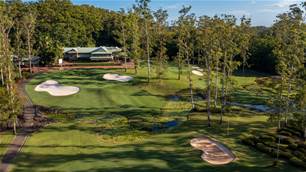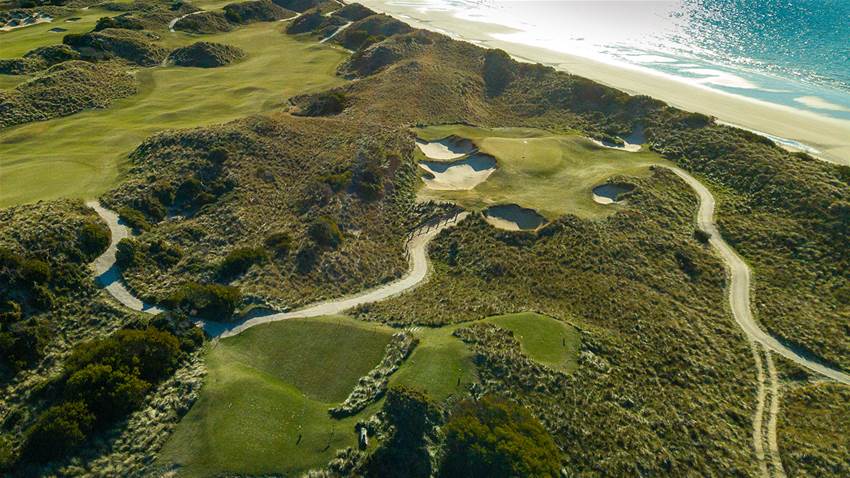Bigger is not always better and, when it comes to golf, the shortest offerings can often provide the most memorable moments during a round. They can be the most picturesque and, in many cases, they can be the most difficult holes.
SOUTH AUSTRALIA (continued)
KOOYONGA GC
152-metre, 7th hole
There are so many great par-3s that play from an elevated tee to a green perched above the other side of a valley and this is one to be included. The green features two levels and any tee shot coming to earth near the front of the putting surface is in danger of rolling back into the deep front bunker or down the trimmed slope off the green.
KOOYONGA GC
145-metre, 14th hole
The most recognisable and famous of Kooyonga’s par 3s, the 14th is a hard club selection hole because of the wind protection offered by surrounding trees. The green is well protected by four deep bunkers and a grassy hollow through the back of the putting surface.

LINKS LADY BAY
184-metre, 17th hole
On a still day this is a stern test of ball-striking, but when a westerly blows in across the course from the Gulf of St Vincent, you might need everything in the bag to find the green. A mis-hit here will either find deep grass atop the surrounding dunes or one of the seven bunkers that ring the putting surface.
MT COMPASS GOLF COURSE
170-metre, 12th hole
Strategically, Mt Compass’ 12th hole asks plenty of questions as you stand on the tee. Featuring a wide green with a large bunker covering most of the front edge, and a small pot bunker back left, working out the best way to access the flag is half of the test here. And I didn’t even mention the water carry.

MT GAMBIER GC
150-metre, 8th hole
The tee sits high above the kidney-shaped green, protected by bunkers – a small one left and a larger sandy hazard right. As is the case with most ‘drop shot’ par-3s, club selection is vital and here the prevailing wind is into the face so take care.
ROBE CC
157-metre, 8th hole
The short climb from the 7th green reveals a wonderful par-3, played across the top of a dune to a large rolling green, protected by a lone bunker.
Designed by Neil Crafter and Paul Mogford and opened for play last November, this is a superb one-shotter combining a beautiful view and challenging golf.
ROYAL ADELAIDE GC
167-metre, 7th hole
The 7th is not an overly long hole, but the superb bunkering and devilish green make it a challenge every time. Small bunkers in front and on each side combine with deep grassy hollows through the back to defend this green.
Royal Adelaide’s best par-3 certainly wouldn’t be out of place on a British Open course like Royal Lytham.

THE GRANGE GC – EAST COURSE
215-metre, 12th hole
An unforgiving par-3 where all the trouble is left of the ideal playing line. In fact, if you find the massive bunker short and left of the putting surface, you could be faced with a 40-metre bunker shot to the flag.
There is a three-club difference between a back and front pin position here, so choose your club wisely.
THE GRANGE GC – WEST COURSE
138-metre, 8th hole
There is always much to be said for short holes where a good player can make a four with one bad swing and the highest markers can make a two with one good one. This is such a hole.
The tee shot needs to carry a sandy wasteland and avoid three bunkers around the edges of the green to have a crack at making a birdie here.
QUEENSLAND
BROOKWATER G&CC
173-metre, 16th hole
Played across the corner of a wetland, designers Greg Norman and Bob Harrison have encouraged brave play here with their angled green and bunker positioning. The left half of the green, nearest a bunker that disappears into the adjoining water hazard, is the most receptive area for incoming tee shots. A second bunker short of the right half of the green is no place to go.

HAMILTON ISLAND GC
175-metre, 4th hole
In the wind, this is one of the most treacherous holes on the Peter Thomson and Ross Perrett-designed layout. The angled green, laid across a ridge, is wide but shallow in depth. Its exposed location provides incredible views to the mainland and Long Island as well as making club selection a stern test.

HAMILTON ISLAND GC
150-metre, 14th hole
Standing on the tee here you almost feel like you’re standing on top of the world with the tee and green being elevated high above its surrounds and the waters of the Whitsunday Passage beyond.
With bunkers surrounding the green on three of the four sides, the tee shot needs to be perfect to find the putting surface.
LAKELANDS GC
133-metre, 14th hole
This is one of the most memorable holes of Jack Nicklaus’ creation at Lakelands. The right-to-left diagonal sitting green sits beyond a waterfall feeding into the adjoining lake and also features a huge sprawling bunker short right. It’s easy to be distracted by the beauty of this hole.

LINKS HOPE ISLAND
188-metre, 17th hole
One of the toughest par-3s in Queensland, Hope Island’s penultimate hole can demand as much club as driver from the back tee when the wind strengthens. Whatever the conditions, the carry over a lake and three pot bunkers cut into the front of the edge of the green is daunting.
PACIFIC HARBOUR G&CC
214-metre, 17th hole
From the tips most players will need to hit driver to reach the green of this hole, appropriately named ‘The Beach’ for the bunker that separates the entire right side of the hole from the adjacent lake. Birdies here are extremely rare so if you happen to make one, treasure it.
ROYAL QUEENSLAND GC
202-metre, 8th hole
The tee shot here, from the tips or forward tees, must carry a water hazard that cuts diagonally across the fairway in front of the green, and continues along the right edge of the hole. Overly cautious players looking to easily carry the water will have to avoid a crop of bunkers left of the green.
ROYAL QUEENSLAND GC
125-metre, 17th hole
This one-shotter is best described as a “little gem with bite”. The tee shot here must carry all the way over a sandy wasteland to reach the slightly elevated green. Sounds easy right? The winds here, however, are fickle and with a putting surface split into two distinct tiers you can easily walk off with a bogey despite hitting the green in regulation.
SANCTUARY COVE G&CC – PINES COURSE
201-metre, 13th hole
From any of the four teeing grounds, it is all water carry to a tiered, well bunkered green. There is an option for shorter hitters to lay up right of the green when playing from the
back pegs. Correct club selection is key here and taking a little more club is a smarter play than going in the water or hitting the rocks that line the edge of the hazard.

THE GLADES GC
173-metre, 5th hole
Designers Greg Norman and Bob Harrison are renowned for intimidating players with visually dramatic bunkering and this one-shotter is a perfect example. An expansive waste bunker lines the left of the hole and is also wedged between the green and a lake. It has the effect of making the generously-sized green appear smaller than it actually is.
Related Articles

RANKING: Australia's Top-100 Courses for 2024

Perfectly Fitting: The ultimate fitting guide













